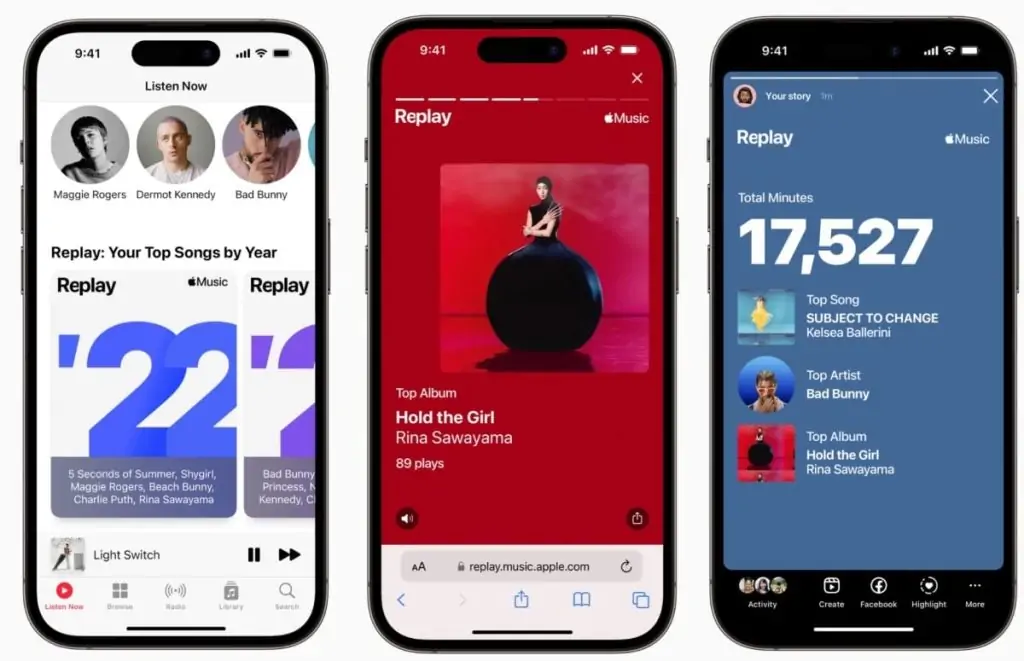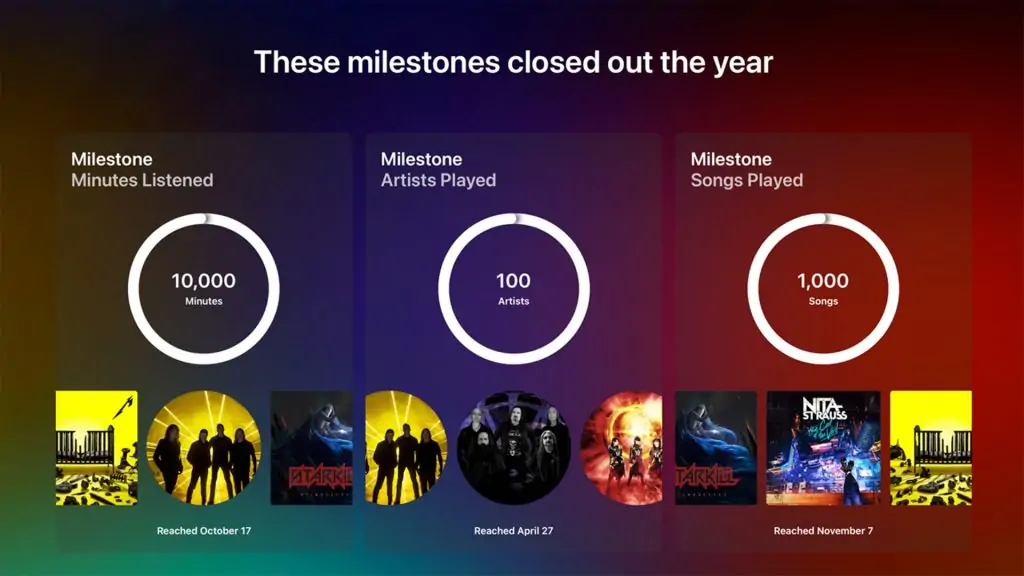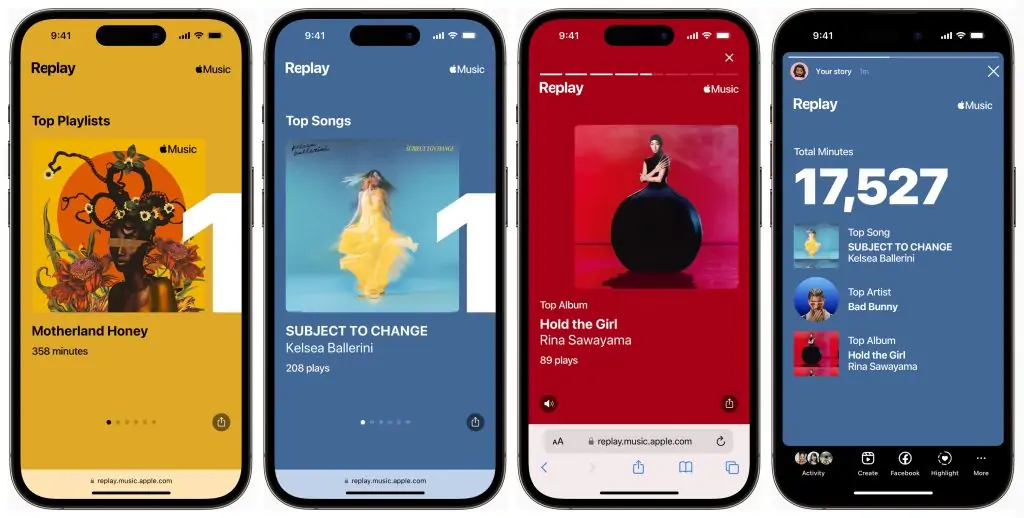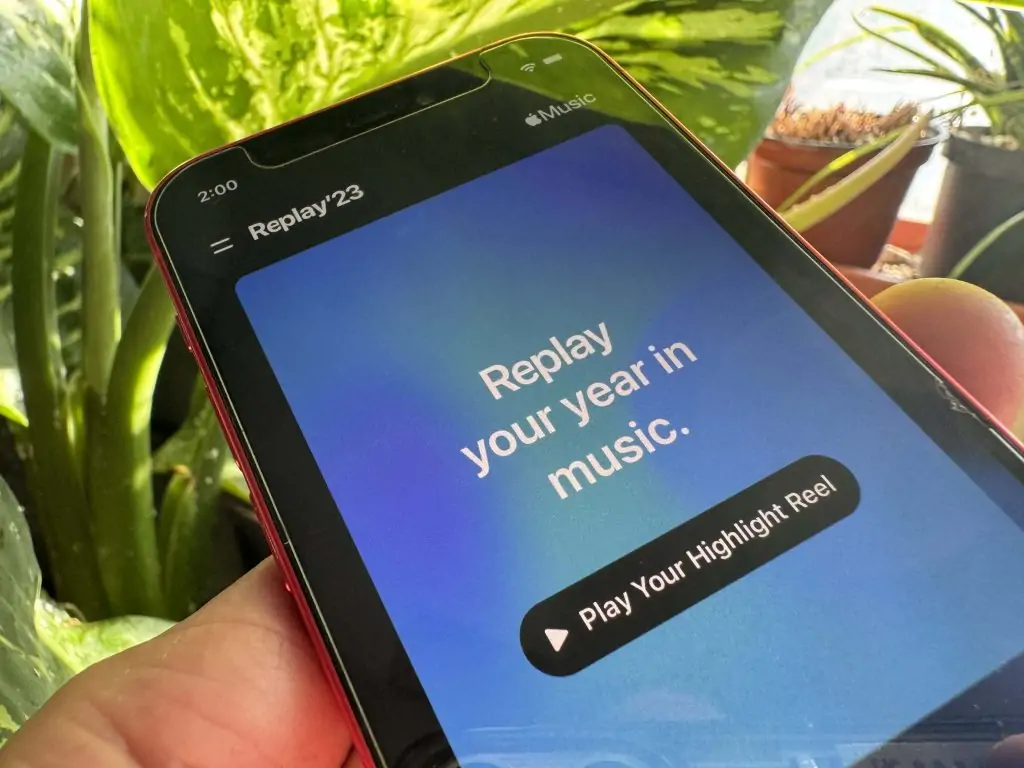Apple Music Replay, As the year gradually comes to a close, there’s an air of reflection that sweeps across music lovers around the globe. For subscribers of Apple Music, this time of year heralds a delightful tradition—Apple Music Replay. This feature offers an intimate and personalized way to celebrate the songs that not only defined the year but also immortalized memorable moments and emotions within listeners’ lives. Whether it’s a catchy pop anthem from summer days or a soulful ballad that offered solace during challenging times, Apple Music Replay crafts a unique experience that resonates deeply with its audience.
What is Apple Music Replay?
At its core, Apple Music Replay is a year-end feature designed to curate a playlist that reflects each user’s unique musical journey over the past twelve months. Unlike traditional music wrap-ups that often highlight mainstream hits or generalized data, Apple Music Replay dives into individual listening habits, showcasing the artists, albums, and tracks that truly resonated with each listener. It guarantees that while everyone else may be celebrating similar hits or nostalgia for the same fleeting trends, what you see in your Replay is exclusively your own—an ever-evolving soundtrack of your life apple music replay 2023.
Apple Music Replay typically becomes available in early December, allowing users to gather insights into their listening trends over the year. Subscribers are presented with fascinating statistics, including their most played songs, favorite albums, and artists who have left a significant mark. It’s not just about recognizing popular tracks; it’s a celebration of personal taste—a digital reflection of how music has served as a backdrop to the diverse experiences accompanying each listener throughout the year apple music replay 2024.

How Does It Work?
The magic of Apple Music Replay lies in its sophisticated algorithm, which meticulously analyzes users’ listening data collected over the entire year. This analysis encompasses not just the number of plays but also other nuanced metrics, such as skips, favorites, and the overall diversity of genres explored. This thoughtful evaluation ensures that the playlists delivered to users are not cookie-cutter reproductions of the year’s most popular music; instead, they bear the unique fingerprints of personal preference replay apple music.
To access Apple Music Replay, users can easily navigate through the Apple Music app or website, where a dedicated “Replay” section awaits. Within this section, subscribers can find a curated playlist titled “Apple Music Replay,” which highlights:
- Most Played Songs: This playlist includes those tracks that have been played most frequently throughout the year, evoking nostalgia and perhaps even prompting memories of specific moments that those songs were part of apple.music replay.
- Top Albums: A comprehensive overview of the albums that received the most love, helping to spotlight those artists whose works may have provided a soundtrack for various stages of life.
- Favorite Artists: This list features a roster of the musicians who had the biggest impact, showcasing the diverse range of talent that caught the user’s ear.
Additionally, Replay is not a one-time reveal; it evolves over time, encouraging users to continue listening and discovering new music throughout the year. This aspect captures the transient nature of musical interests, allowing for a live glimpse into shifting preferences and discoveries.

The Visual Experience
One of the standout features that enhance the allure of Apple Music Replay is the compelling visual presentation that accompanies it. Users are greeted not just with playlists, but with a beautifully designed interface that brings their listening statistics to life. The visuals include:
- Custom Graphics: Unique artwork that accompanies each playlist, providing an engaging aesthetic experience that elevates the overall user enjoyment. The dynamic visuals often encapsulate the themes and moods of the music selected, creating an immersive experience.
- Listening Insights: Infographics slide in to showcase notable stats—like the total number of hours spent listening or the diversity of genres explored—providing tangible knowledge of the user’s musical journey.
- Sharing Capabilities: With a few simple clicks, users can share their Replay playlists and statistics on social media platforms, allowing friends and followers to join in the celebration of their musical preferences. This feature not only opens up opportunities for lively discussions about favorites and recommendations but also fosters a community centered around shared musical experiences.

Why Apple Music Replay Matters
In an age where music is consumed rapidly and often without reflection, Apple Music Replay is a refreshing reminder of the power of music to evoke emotions, create memories, and solidify connections. It transforms passive listening into an engaging exploration of personal identity through sound. Not only does it prompt users to slow down and appreciate their musical explorations, but it also serves as an invaluable tool for self-discovery and artistic appreciation.
Moreover, as music streaming services become the primary mode of consumption, features like Apple Music Replay help users connect with their listening habits on a deeper level. It empowers listeners to not only recall what they enjoyed but also to confront their evolving tastes, encouraging them to re-engage with albums and artists they might have forgotten amidst the din of new releases.
Apple Music Replay does not merely exist in isolation; its impact extends into the broader music community as well. The feature facilitates a collective journey through music, inviting users to share their Replay statistics and engage in conversations that celebrate the diverse narratives represented in their playlists. As subscribers share their unique top tracks and conduct friendly debates on favorites, it helps foster a sense of belonging within the music-loving community and bridges connections—be it with friends or with fellow listeners from around the globe.
In an industry where collaboration and connections are essential, Replay nudges music lovers to explore new genres, listen to recommendations from friends, and discover hidden gems through shared experiences.

Future of Apple Music Replay
As the landscape of music consumption continues to evolve, so, too, does the potential for Apple Music Replay. There are numerous opportunities for enhancements that could elevate the user experience even further. Future iterations of Replay may incorporate deeper analytical features that provide insights into genre specificity or emotional context, effectively charting listening preferences based on mood or environment.
Additionally, there is potential for incorporating augmented reality (AR) or interactive elements into the graphical representations, allowing users to experience their musical history in new and immersive ways. This could include interactive timelines charting their musical evolution or even granting access to behind-the-scenes content regarding their most loved artists and albums.
Furthermore, as competition within the streaming industry intensifies, Apple Music may explore additional personalization capabilities. This would enable users to curate playlists based on specific themes, events, or even seasonal preferences, thereby enriching the overall listening experience and lending itself to the growing trend of curated content.
In a world teeming with distractions and ever-shifting trends, Apple Music Replay provides a heartwarming and personalized lens through which listeners can celebrate their musical journeys. By offering tailored insights, engaging visuals, and an avenue for social sharing, Replay exemplifies how technology can enhance art, transforming the way we connect with the music that shapes our lives.
As subscribers look back on their musical year and reflect on the songs that sparked joy, comfort, and inspiration, Apple Music Replay serves as a delightful reminder of why music holds such a significant place in our hearts. With that in mind, as we transition into the new year, we not only carry forward our fondness for beloved tracks, but also a renewed enthusiasm for discovering new sounds and artists that will undoubtedly become part of our next musical journey.
With the crescendoing anticipation for future musical endeavors, Replay ultimately positions itself as an essential companion in every listener’s evolving narrative—encouraging exploration, fostering community, and celebrating the poignant power of music to connect us all. Whether reminiscing about cherished tracks or uncovering new favorites, Apple Music Replay ensures that the soundtrack of our lives continues to be one of exploration, joy, and profound connection.
How Does Apple Music Replay Work?
The standout aspect of Apple Music Replay is how it works behind the scenes. Apple utilizes sophisticated algorithms to analyze each subscriber’s listening data, which includes the number of times a song has been played, skipped, and favorited. This analysis culminates in a set of engaging statistics and curated playlists that highlight:
- Top Songs: A playlist of the most frequently played tracks by the user, transporting them back to moments that these songs have soundtracked.
- Favorite Albums: An overview of the albums that users listened to the most, showcasing the full-length works that made an impact throughout the year.
- Top Artists: A curated list of the artists who defined the user’s musical landscape, illustrating the genres and influences that shaped their listening experience.
Apple Music Replay doesn’t stop at serving up playlists—it evolves. Throughout the year, it updates weekly, allowing users to view shifts in their listening habits in real-time. This adaptability makes it more than a recap; it’s a living exploration of the user’s evolving musical preferences.
Apple Music Replay is as much about the experience as it is about the data. Subscribers are welcomed with visually striking graphics that bring their listening statistics to life. Key highlights include:
- Custom Artwork: Each playlist is accompanied by unique artwork that aligns with the mood and themes of the tracks, enhancing the aesthetic experience.
- Insightful Infographics: These graphics reveal fun facts about the user’s listening habits, such as total hours streamed, favorite genres, and the diversity of music explored, presenting a comprehensive view of their musical journey.
- Shareability: One of the most delightful features of Apple Music Replay is its shareability. Users can easily share their yearly playlists and statistics on social media platforms, inviting friends and followers to engage with their musical tastes. This encourages conversation, discovery, and deeper connections among fellow music enthusiasts.
Why Apple Music Replay Matters
Apple Music Replay resonates significantly in an age marked by fleeting trends and disposable content. It stands as a testament to the enduring impact of music in our lives, allowing users to celebrate their unique soundtracks and the memories associated with them. This feature transforms the act of listening to music from a passive pastime into an engaging exploration of identity and emotion.
In a culture increasingly dominated by algorithms, where playlists are often generated based on popularity rather than personal preference, Apple Music Replay provides a much-needed antidote. It allows users to recognize and embrace their flaws and specialties, enabling a deeper connection with the music that shapes their experiences.
Beyond individual reflection, Apple Music Replay fosters a sense of community among its subscribers. As users share their playlists and statistics, it creates an environment ripe for discussion about music preferences, recommendations, and the personal connections that music fosters. Engaging in these conversations can lead to discovering new artists, genres, or even collaborating on playlists, thus expanding one’s musical horizons.
What’s Next for Apple Music Replay?
As technology continues to evolve, the future of Apple Music Replay appears bright with possibilities. There is ample room for enhancements that could make the experience even more engaging. Future iterations may incorporate advanced analytics, providing insights based on specific listening contexts or emotional responses, thereby adding more depth to the personalized experience.
Additionally, the integration of interactive features—such as gamification elements—could encourage users to actively engage with their playlists in new and exciting ways, turning music exploration into a collaborative social experience.
As we wrap up another year, Apple Music Replay provides users with a heartfelt invitation to reflect on the music that has accompanied their lives—the ebbs and flows, the ups and downs, the moments of solitude and celebration. It serves as a digital time capsule of memories, infused with the colors of personal experiences and emotional connections.
In a landscape saturated with music options, Apple Music Replay stands out as a cherished feature that emphasizes individuality in a collective society. So, whether you’re listening to the top hits that shaped your summer or the soothing melodies that helped you unwind during a hectic year, Apple Music Replay ensures your soundtrack is personalized, meaningful, and entirely your own. As you dive into your Replay playlist, take a moment to celebrate the power of music in enhancing our lives and shaping our memories—a reflection that continues to resonate long after the final note fades away in apple music replay playlist.
Exploring Your Music Options: A Deep Dive into the World of Sound
In a world where sonic landscapes are constantly evolving, the ways in which we interact with music have transformed dramatically. From the rise of streaming services to the resurgence of vinyl and the various digital platforms available, music lovers have never had it easier to access their favorite songs, albums, and genres. This article aims to explore the myriad options available for enjoying music today—examining the formats, platforms, and experiences that define our contemporary listening habits.
1. Streaming Services: The New Era of Music Consumption
The digital revolution has ushered in the dominance of streaming services, fundamentally changing the way we listen to music. Services like Spotify, Apple Music, Amazon Music, and YouTube Music have made vast libraries of songs accessible at the touch of a button, for a monthly subscription or even for free, with ads.
- Advantages:
- Vast Libraries: With millions of tracks available, users can explore a diverse range of genres and artists, often including exclusive releases and acoustic versions.
- Personalization: Algorithms curate playlists and recommend new music based on individual listening habits, making discovery exciting and tailored.
- Accessibility: Users can listen on various devices—from smartphones to smart speakers—making it easier than ever to integrate music into their daily lives.
- Disadvantages:
- Subscription Costs: While there are free options, high-quality ad-free experiences often come with a monthly fee, which can add up.
- Ownership: Streaming services require an internet connection, and users do not technically own the music they listen to, raising concerns about access if a service discontinues a title or goes out of business.
2. Digital Downloads: Ownership in the Digital Age
In contrast to streaming, digital downloads provide a sense of ownership. Platforms like iTunes, Bandcamp, and Amazon Music allow users to purchase and download songs or albums directly to their devices.
- Advantages:
- Ownership: Once purchased, users own the music and can play it without an internet connection.
- Supporting Artists: Purchasing directly from platforms like Bandcamp often allows artists to earn a more significant portion of the revenue, empowering and supporting independent musicians.
- Disadvantages:
- Cost: Individual songs and albums can be pricier than subscription service fees, especially for frequent listeners.
- Storage: Digital files require storage space, which can be a drawback for users with limited device memory.
3. Vinyl Records: A Physical Revival
In recent years, there has been a remarkable resurgence in the popularity of vinyl records. Music lovers are gravitating towards the tangible experience of owning physical recordings, often accompanied by beautiful artwork and large album covers.
- Advantages:
- Sound Quality: Many enthusiasts argue that vinyl offers a warmer, richer sound compared to compressed digital formats.
- Collectibility: Vinyl records can serve as collectibles, with limited editions, colored pressings, and unique artwork attracting both audiophiles and casual listeners alike.
- Aesthetic Appeal: The visual and tactile experience of handling records can create a deeper connection to the music.
- Disadvantages:
- Cost and Accessibility: Vinyl can be more expensive than digital formats, and not all albums are available on vinyl.
- Space and Equipment: Collecting records requires space for storage and a quality turntable for playback, which can be a barrier for some listeners.
4. Live Music: The Ultimate Experience
Attending live music events is an experience that cannot be replicated. Whether it’s a local gig at a small venue or a massive concert in a stadium, live performances bring a unique energy and communal aspect to music enjoyment.
- Advantages:
- Connection: Experiencing music in real-time with other fans can create unforgettable memories, as performers and audiences forge an emotional connection.
- Atmosphere: The ambiance of a live show—the lights, the crowd, the energy—can elevate the experience beyond just listening.
- Disadvantages:
- Costs: Concert tickets, travel, and accommodations can add up, making live events a significant financial commitment.
- Accessibility: Not everyone can easily attend live shows due to location, age restrictions, or health concerns.
5. Online Platforms and Social Media: Discovering New Music
Platforms like SoundCloud, Instagram, and TikTok are revolutionizing how music is discovered and enjoyed. Artists share their music directly with audiences, often leading to viral trends and broader reach.
- Advantages:
- Discoverability: Emerging artists can gain traction without a record label, reaching vast audiences through viral content.
- Community Engagement: Fans can engage with artists through comments and shares, creating a sense of community around music.
- Disadvantages:
- Quality Control: The open nature of these platforms means that while discovery is easier, it can also result in a lot of lower-quality content.
- Attention Span: The fast-paced nature of social media may lead to fleeting interest in songs or trends, making it difficult for artists to build a loyal fanbase.
6. Customization and Technology: The Future of Music Listening
Innovative technology is continually shaping how we experience music.
- Smart Speakers and AI: Devices like Amazon Echo and Google Nest have integrated voice commands and smart features, allowing users to play music hands-free. AI-generated playlists and radio stations are improving, offering personalized listening experiences based on mood and preferences.
- Music Creation and Collaboration Platforms: Platforms like Ableton Live and Splice empower aspiring musicians to create and collaborate, pushing the boundaries of music accessibility and production.
In an age of abundant choices, exploring various music options is essential for discovering the sounds that resonate most deeply. From streaming services and digital downloads to vinyl records and live performances, each format offers something unique and valuable.
Ultimately, the way you choose to enjoy music should align with your personal preferences, lifestyle, and values. Whether you immerse yourself in the analog warmth of vinyl, explore the digital frontier of online streaming, or revel in the magic of live performances, the world of music offers a diverse array of options that enrich our lives and serve as a soundtrack to our experiences. So dive in, discover, and let your own musical journey unfold!
How to find your apple music replay
To find your Apple Music Replay, you can do the following:
Open the Apple Music app
Go to the Listen Now tab
Scroll down to the Replay: Your Top Songs by Year section
Click on Replay
You can also access your Apple Music Replay on the web by going to replay.music.apple.com and logging in with your Apple ID.
If you can’t see your Replay, you can check that Use Listening History is turned on for all of your devices. Here’s how:
iPhone or iPad: Go to Settings > Music and turn on Use Listening History
Mac: In the Apple Music app, choose Music > Settings, click the General tab, then select Use Listening History
Android: At the top of the Apple Music app, tap the More button, tap Settings, then turn on Use Listening History
Apple Music Replay uses your listening history to calculate your top songs, albums, artists, playlists, genres, and stations. It also includes information like the total minutes listened and play count for each song.
How to get your apple music replay
To get your Apple Music Replay, you can do the following:
Open the Apple Music app
Go to Home or Listen Now
Scroll down to Replay: Your Top Songs by Year
You can also access your Replay on the web at replay.music.apple.com.
If you don’t see your Replay, you can check that Use Listening History is turned on for all of your devices:
iPhone or iPad: Go to Settings > Music
Mac: In the Apple Music app, choose Music > Settings, click the General tab, then select Use Listening History
Android: At the top of the Apple Music app, tap the More button, tap Settings, then turn on Use Listening History
Once you’ve played enough music, you’ll receive a notification that your Replay is ready.
Your Replay playlist includes your top songs, albums, and artists, as well as other listening insights. You can also share your Replay playlist on social media.
How to check apple music stats
To see the top artists you’ve listened to this year, artist play counts, and listening hours,sign in with the email you use for your Apple Music subscription.Select “Get Started,” and your music and artist insights will display.Jan 9, 2024
Does apple music have wrapped
ButApple Music users do get their own version of Spotify Wrapped—although it’s not officially called “Apple Music Wrapped.” Their version is called Apple Music Replay, and it offers users a similar rundown of what they listened to over the last year.
How to see your apple music stats
To see the top artists you’ve listened to this year, artist play counts, and listening hours,sign in with the email you use for your Apple Music subscription.Select “Get Started,” and your music and artist insights will display.
How to see apple wrapped
Apple Music Replay is similar to Spotify Wrapped, but it’s more dynamic and available all year. In addition to your year-end Replay, you can also see your top songs, artists, and albums every month.
How to see most played song on apple music
To see your most played song on Apple Music, you canuse the Replay feature to view your personalized charts of top songs, artists, and albums:
Go to replay.music.apple.com
Sign in with the Apple ID you use for Apple Music
Click Jump In
You can also see your Replay in the Apple Music app on your iPhone:
Open the Music app
Tap Home
Swipe down to Replay: Your Top Songs by Year
Tap a year
Apple Music creates a Replay for each year you’ve subscribed and played enough music. You can also see monthly insights, including your top songs, artists, and albums.



